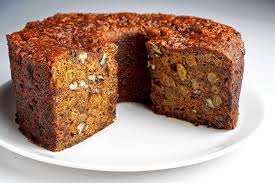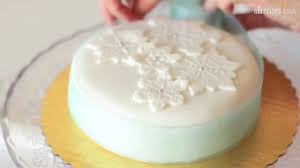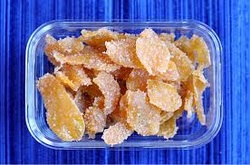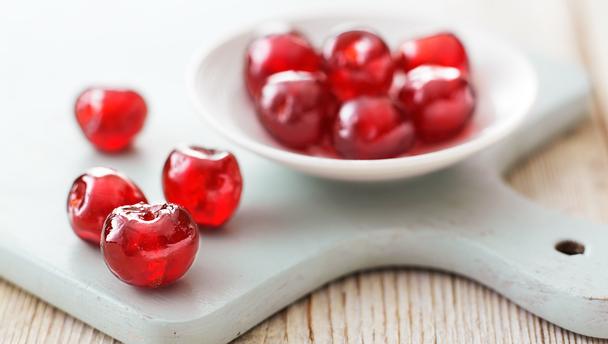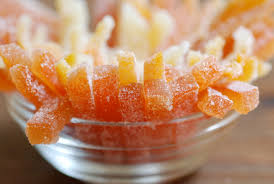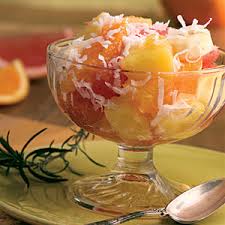<< PREVIOUS SECTION < PREVIOUS PAGE NEXT PAGE > NEXT SECTION >>
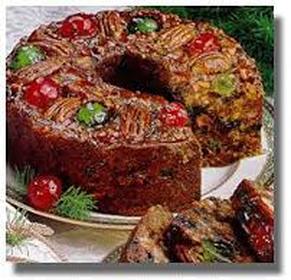
Fruitcake is a much-maligned dessert. It is the target of many rude holiday jokes and the object of heartless re-gifting. Our cousin Richard has been known to make remarks about spare tires and doorstops while eyeing the large round Christmas fruitcake on its pedestal. However, we have noted that he is the first to saw his way through the huge dense pastry, slather it with hard sauce and dig in.
Modern food purists who disparage the candied fruits and long life of fruitcake fail to appreciate the history of this ancient dessert. Fruitcakes were developed in many European countries hundreds of years ago to preserve summer fruits and nuts so that they could still be enjoyed during the winter holidays when the outside world is dark and covered with snow. Before the advent of refrigeration, summer fruits were preserved by soaking them in brandy, honey or sugar, and candied fruits, especially cherries and citrus peels, became a staple of winter festivities. If you find the high fructose corn syrup and food coloring in commercially prepared candied fruit cloying, we are happy to provide easy recipes for making your own candied fruits and peels.
The cakes themselves can be made months before the holidays, soaked in brandy or sweetened fruit juice and aged in a metal cake box in a cool dark place. Far from making the fruitcakes unpalatable, this process allows the ingredients to meld and mellow, enhancing both the flavor and texture of a classic fruitcake. In England, when it is time to serve the cake, it is traditional to cover the top of the cake with thinly rolled out marzipan and decorate it with Royal Icing and additional candied fruits, silver sprinkles or colored sugar. A marzipan topped Christmas fruitcake is the pinnacle of the joyful holiday feast.
For those of you who are willing to give fruitcake a chance, we offer three additional versions, from very traditional to contemporary and from simple to complex. Any one of these cakes will add to the glory of the Christmas celebration.
Modern food purists who disparage the candied fruits and long life of fruitcake fail to appreciate the history of this ancient dessert. Fruitcakes were developed in many European countries hundreds of years ago to preserve summer fruits and nuts so that they could still be enjoyed during the winter holidays when the outside world is dark and covered with snow. Before the advent of refrigeration, summer fruits were preserved by soaking them in brandy, honey or sugar, and candied fruits, especially cherries and citrus peels, became a staple of winter festivities. If you find the high fructose corn syrup and food coloring in commercially prepared candied fruit cloying, we are happy to provide easy recipes for making your own candied fruits and peels.
The cakes themselves can be made months before the holidays, soaked in brandy or sweetened fruit juice and aged in a metal cake box in a cool dark place. Far from making the fruitcakes unpalatable, this process allows the ingredients to meld and mellow, enhancing both the flavor and texture of a classic fruitcake. In England, when it is time to serve the cake, it is traditional to cover the top of the cake with thinly rolled out marzipan and decorate it with Royal Icing and additional candied fruits, silver sprinkles or colored sugar. A marzipan topped Christmas fruitcake is the pinnacle of the joyful holiday feast.
For those of you who are willing to give fruitcake a chance, we offer three additional versions, from very traditional to contemporary and from simple to complex. Any one of these cakes will add to the glory of the Christmas celebration.
|
Patience
I throw the ball for the golden retriever And just as it arches upward, A single oak leaf flutters down. The dog’s body is still hard and ready to run, Though his muzzle has started to whiten. For eleven autumns he has run With the dawn and the dusk, And the light of shifting seasons Has fallen on his flowing coat In spring the sun surrounds him In ropes of gold, And on summer evenings The twilight sifts through his long tresses Like old roses under the moon. I remember a Christmas morning When the pale sun descended like a crown of silver On his garnet-glistening fur, And his breath in the still air Was white as lace. |
In dog years, he is older than my father,
Who seems very old and has aged like peanut brittle. Dogs are like winter fruitcake-- Deep and sweet, Made out of good old things And always on hand. |
MENU
Kathleen’s Fruitcake without Candied Fruit
Country Christmas Cake with Marzipan and Royal Icing
Royal Icing
Candied Ginger
Candied Cherries
Candied Citrus Peel
Ambrosia
Easy Orange Pound Cake with Candied Cranberries
Candied Cranberries
Kathleen’s Fruitcake without Candied Fruit
Country Christmas Cake with Marzipan and Royal Icing
Royal Icing
Candied Ginger
Candied Cherries
Candied Citrus Peel
Ambrosia
Easy Orange Pound Cake with Candied Cranberries
Candied Cranberries
|
Kathleen’s Fruitcake without Candied Fruit
This luscious, lightly spiced golden fruitcake is made with readily available dried fruits rather than candied fruits. The effect is a contemporary California cuisine kind of cake made with very traditional and time-honored techniques. The recipe can be made in a variety of pan shapes and sizes. Plan to make your fruitcakes up to three months before they are needed to serve at a holiday party or to give as gifts. The larger sizes usually respond best to longer aging. Use plenty of good quality brandy or rum to sprinkle on the cakes as they age. Country Christmas Cake with Marzipan and Royal Icing We found the recipe for this glorious traditional English fruitcake in the December 1991 issue of Gourmet magazine. It appeared in an article by Laurie Colwin, who credits Jane Grigson, author of English Food, with this very old Christmas recipe. According to Laurie Colwin, “Country Christmas Cake has a rich, deep taste, as complicated as a brocade or tapestry … Most impressive is the fact that you have made this gorgeous, amazing traditional cake yourself from an ancient recipe. Hands down, it is the best I have ever made—and also the best I have ever eaten.” Rose has also made this cake, and she concurs with Laurie’s assessment, although Rose loves all of the fruitcakes we have included for you to sample. Even though the list of ingredients is long, the cake itself is easy to make. It follows a procedure similar to Kathleen’s Fruitcake without Candied Fruit, and like Kathleen’s fruitcake, Country Christmas Cake is made several weeks or months in advance and aged in brandy. The aging process helps to create the “brocade”-like complexity of the cake’s flavor. Unlike Kathleen’s cake, this one does contain candied fruit, and the final product is topped with marzipan and decorated with royal icing before being served on Christmas Day or at your special Christmas Afternoon Tea. Surprisingly, this fruitcake contains no nuts, so it would be a good choice if you have guests with food allergies. Even if you make this cake only once in your lifetime, the process of making and enjoying this cake, in solidarity with thousands of bakers and home cooks who have gone before you, is an experience you and your guests will never forget. Candied Ginger Candied ginger has all kinds of uses, especially during the holidays. It can be chopped and added to various kinds of cookies from shortbread to gingerbread, and it is a delicious addition to fruitcake. It is wonderful dipped in chocolate, and it is also very festive minced into tiny pieces and sprinkled over ice cream or added to the Christmas Trifle. Once you have a supply of candied ginger in your pantry, you will discover that it makes almost any dessert more elegant and mysteriously flavorful. Candied Cherries Candied fruits are ancient treats that have been popular throughout Europe for millennia. Even today, European pastry shops and specialty stores sell all kinds of candied fruits, some of which look too beautiful to eat. Rose was dazzled by a visit to a shop in Sicily where whole candied oranges, figs, apricots and prunes where piled high on elegant serving trays like precious jewels. Sadly the American versions of candied fruits are usually sold in grocery stores in plastic tubs, and the contents are an unappealing mass of artificially colored lumps swimming in high fructose corn syrup. You can resurrect this elegant winter delight by making your own candied cherries from summer’s bounty. We recommend using dark sweet Bing cherries for their beautiful color and texture. Candied Citrus Peel Candied citrus peel—orange, lemon or grapefruit, can be used for any number of delightful desserts. Candied peel can be dipped in chocolate and served as a candy, chopped and added to pound cakes or holiday yeast breads, cut into small pieces and incorporated into the filling for cannoli or even added to homemade spumoni ice cream. These are just a few of the many possible culinary uses for candied citrus peel, and candied cherries would be just as pleasing in any of these applications. Ambrosia Ambrosia is a Southern American treasure, which as its name suggests, tastes heavenly. It harks back to the days when sailing ships plied the seas between the Southeastern seaboard and the Caribbean islands, trading sugar cane for rum and importing tropical fruits such as pineapples, coconuts and bananas. In its simplest form, Ambrosia is a combination of three fresh fruits cut up and served in a cut crystal bowl—oranges, pineapple and coconut. This fresh fruit mélange creates a sparkling, golden effect and tastes perfect without any additions. You might want to serve Ambrosia with the Orange Pound Cake (recipe below) instead of the candied cranberries for a Southern Christmas dessert. However, Ambrosia can also be served with the Christmas ham and candied yams as a fruit salad or condiment. Inevitably, home cooks cannot resist the temptation to add more ingredients to an already perfect combination, and common additions to Ambrosia include miniature marshmallows, sliced bananas, red grapes, and even rum. Children especially like Ambrosia with marshmallows, and if children will be present at your celebration, why not add some? But Ambrosia spiked with rum is for adults only. Truthfully Ambrosia needs no dressing or added flavorings, as the natural mixture of fruit juices creates a wonderful flavor. However, if you have candied cherries on hand (recipe above,) you might want to add a few for extra holiday color and taste. Easy Orange Pound Cake with Candied Cranberries This cake, which is incredibly easy to make, is for the novices among our readers. It is not really a fruitcake at all but a yellow cake mix enhanced with freshly grated orange peel and fresh orange juice. These simple additions to a box cake mix will help you create a Christmas masterpiece that tastes delicious and sings with holiday spirit. Surrounded by glittering, jewel-like candied cranberries and presented on an elegant cake pedestal, this cake reminds us of traditional English pound cakes served with preserved fruits during the winter season. Our recipe calls for two sizes of grated orange peel, large and small. The larger pieces of peel are placed on top of the glazed cake and in the candied cranberries for visual appeal, while the smaller pieces add color and flavor to the cake itself. If you only have one size grater, you can make all of the peel the same size. |


